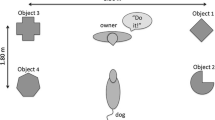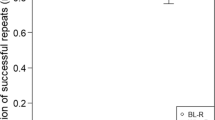Abstract
This study demonstrates for the first time deferred imitation of novel actions in dogs (Canis familiaris) with retention intervals of 1.5 min and memory of familiar actions with intervals ranging from 0.40 to 10 min. Eight dogs were trained using the ‘Do as I do’ method to match their own behaviour to actions displayed by a human demonstrator. They were then trained to wait for a short interval to elapse before they were allowed to show the previously demonstrated action. The dogs were then tested for memory of the demonstrated behaviour in various conditions, also with the so-called two-action procedure and in a control condition without demonstration. Dogs were typically able to reproduce familiar actions after intervals as long as 10 min, even if distracted by different activities during the retention interval and were able to match their behaviour to the demonstration of a novel action after a delay of 1 min. In the two-action procedure, dogs were typically able to imitate the novel demonstrated behaviour after retention intervals of 1.5 min. The ability to encode and recall an action after a delay implies that facilitative processes cannot exhaustively explain the observed behavioural similarity and that dogs’ imitative abilities are rather based on an enduring mental representation of the demonstration. Furthermore, the ability to imitate a novel action after a delay without previous practice suggests presence of declarative memory in dogs.


Similar content being viewed by others
References
Akins CK, Zentall TR (1996) Imitative learning in male Japanese quail (Coturnix japonica) using the two-action method. J Comp Psychol 110:316–320
Bandura A (1969) Social learning theory of identificatory processes. In: Goslin DA (ed) Handbook of socialization theory and research. Rand-McNally, Chicago, pp 213–262
Barnat SB, Klein PJ, Meltzoff AN (1996) Deferred imitation across changes in context and object: memory and generalization in 14-month-old infants. Infant Behav Dev 19:241–251
Barr R, Dowden A, Hayne H (1996) Developmental changes in deferred imitation by 6- to 24-month-old infants. Infant Behav Dev 19:159–170
Bjorklund DF, Bering JM (2003) A note on the development of deferred imitation in enculturated juvenile chimpanzees (Pan troglodites). Dev Rev 23:389–412
Byrne RW (1994) The evolution of intelligence. In: Slater PJB, Halliday TR (eds) Behaviour and evolution. Cambridge University Press, Cambridge, pp 223–264
Carpenter M, Nagell K, Tomasello M (1998b) Social cognition, joint attention, and communicative competence from 9 to 15 months of age. Monogr Soc Res Child 63 (Serial No. 255)
Dawson BV, Foss BM (1965) Observational learning in budgerigars. Anim Behav 58:151–158
Dorrance BR, Zentall TR (2001) Imitative learning in Japanese quail (Coturnix japonica) depends on the motivational state of the observer quail at the time of observation. J Comp Psychol 115:62–67. doi:10.I037//0735-7036.115.1.62
Fiset S, Beaulieu C, Landry F (2003) Duration of dogs’ (Canis familiaris) working memory in search for disappearing objects. Anim Cogn 6:1–10
Galef BJ (1988) Imitation in animals: history, definition, and interpretation of data from the psychological laboratory. In: Zentall TR, Galef BJ (eds) Social learning: psychological and biological perspectives. Erlbaum, Hillsdale, NJ, pp 3–28
Hare B, Tomasello M (2005) Human-like social skills in dog? Trends Cogn Sci 9:439–444. doi:10.1016/j.appalinm.2005.11.018
Hare B, Brown M, Williamson C, Tomasello M (2002) The domestication of social cognition in dogs. Science 298:1634–1636. doi:10.1126/science.1072702
Hayes KJ, Hayes C (1952) Imitation in a home-raised chimpanzee. J Comp Psychol 45:450–459
Heyes C, Sagerson A (2002) Testing for imitative and non-imitative social learning in the budgerigar using a two-object/two action test. Anim Behav 64:851–859
Horner V, Whiten A (2005) Causal knowledge and imitation/emulation switching in chimpanzees (Pan troglodites) and children (Homo sapiens). Anim Cogn 8:164–181. doi:10.1007/s10071-004-0239-6
Huber L, Range F, Voelkl B, Szucsich A, Virányi Z, Miklósi Á (2009) The evolution of imitation: what do the capacities of non-human animals tell us about the mechanisms of imitation? Phil. Trans R Soc B 364:2299–2309. doi:10.1098/rstb.2009.0060
Klein PJ, Meltzoff AN (1999) Long-term memory, forgetting and deferred imitation in 12-month-old infants. Dev Sci 2:102–113
Kubinyi E, Miklósi Á, Topál J, Csányi V (2003) Dogs (Canis familiaris) learn from their owners via observation in a manipulation task. J Comp Psychol 117(2):156–165
Kubinyi E, Pongrácz P, Miklósi Á (2009) Dog as a model for studying conspecific and heterospecific social learning. J Vet Behav 4:31–41
Kupan K, Miklósi Á, Gergely G, Topál J (2010) Why do dogs (Canis familiaris) select the empty container in an observational learning task? Anim Cogn. doi:10.1007/s10071-010-0359-0
Meltzoff AN (1995) Understanding the intentions of others: re-enactment of intended acts by 18-month-old children. Dev Psychol 31:838–850
Miklósi Á, Soproni K (2006) A comparative analysis of animals’ understanding of the human pointing gesture. Anim Cogn 9:81–93. doi:10.1007/s10071-005-0008-1
Miklósi Á, Topál J (2013) What does it take to become ‘best friends’? Evolutionary changes in canine social competence. Trends Cogn Sci 17:287–294. http://dx.doi.org/10.1016/j.tics.2013.04.005
Miklósi Á, Kubinyi E, Topál J, Gácsi M, Virányi Z, Csányi V (2003) A simple reason for a big difference: wolves do not look back at humans but dogs do. Curr Biol 13:763–766
Miklósi Á, Topál J, Csányi V (2007) Big thoughts in small brains? Dogs as a model for understanding human social cognition. NeuroReport 18:467–471
Miller HC, Rayburn-Reeves R, Zentall T (2009) Imitation and emulation by dogs using a bidirectional control procedure. Behav Process 80:109–114. doi:10.1016/j.beproc.2008.09.011
Óturai G, Kolling T, Hall LR, Knopf M (2012) The role of object functions for deferred imitation—do infants selectively retain and forget target actions? Infant Behav Dev 35:195–204
Piaget J (1952) The origins of intelligence in children. International University Press, New York
Pongracz P, Miklósi Á, Kubinyi E, Gurobi K, Topal J, Csanyi V (2001) Social learning in dogs: the effect of a human demonstrator on the performance of dogs in a detour task. Anim Behav 62:1109–1117. doi:10.1006
Pongrácz P, Miklósi Á, Timar-Geng K, Csányi V (2003) Preference for copying unambiguous demonstrations in dogs (Canis familiaris). J Comp Psychol 117:337–343
Pongrácz P, Bánhegyi P, Miklósi A (2012) When rank counts—dominant dogs learn better from a human demonstrator in a two-action test. Behaviour 149:111–132
Reid P (2009) Adapting to the human world: dogs’ responsiveness to our social cues. Behav Process 80:325–333
Thorpe WH (1963) Learning and instinct in animals, 2nd edn. Harvard University Press, Cambridge, MA
Tomasello M (1990) Cultural transmission in tool use and communicatory signalling of chimpanzees. In: Parker S, Gibson K (eds) ‘Language’ and intelligence in monkeys and apes: comparative developmental perspectives. Cambridge University Press, Cambridge, pp 274–311
Topál J, Byrne R, Miklósi Á, Csányi V (2006) Reproducing human actions and action sequences: “Do as I Do!” in a dog. Anim Cogn 9:355–367. doi:10.1007/s10071-006-0051-6
Van de Waal E, Claidière N, Whiten A (2012) Social learning and spread of alternatives means of opening an artificial fruit in four groups of vervet monkeys. Anim Behav 30:1–6. http://dx.doi.org/10.1016/j.anbehav.2012.10.008
Whiten A, Custance D (1996) Studies in imitation in chimpanzees and children. In: Heyes CM, Galef BG (eds) Social learning in animals: the roots of culture. Academic Press, San Diego, pp 291–318
Wood D (1989) Social interaction as tutoring. In: Bornstein MH, Bruner JS (eds) Interaction in human development. Erlbaum L, Hillsdale, New Jersey, pp 59–80
Zentall TR (2006) Imitation: definitions, evidence, and mechanisms. Anim Cogn 9:335–353. doi:10.1007/s1007-006-0039-2
Acknowledgments
This study was supported by the Hungarian Scholarship Board by providing a fellowship to C. Fugazza. A.M. also receives funding from MTA-ELTE Comparative Ethology Group (MTA01 031), and the Hungarian Science Foundation (OTKA K81953). We are also grateful to the dog owners of the Good Boy and Happy Dog School who enthusiastically participated in this research with their dogs. We thank L. Marinelli for her comments on the manuscript, C.P. West for proofreading the English of this article and the anonymous reviewers for their valuable suggestions.
Author information
Authors and Affiliations
Corresponding author
Electronic supplementary material
Below is the link to the electronic supplementary material.
Supplementary material 1 (MP4 54241 kb)
Rights and permissions
About this article
Cite this article
Fugazza, C., Miklósi, Á. Deferred imitation and declarative memory in domestic dogs. Anim Cogn 17, 237–247 (2014). https://doi.org/10.1007/s10071-013-0656-5
Received:
Revised:
Accepted:
Published:
Issue Date:
DOI: https://doi.org/10.1007/s10071-013-0656-5




